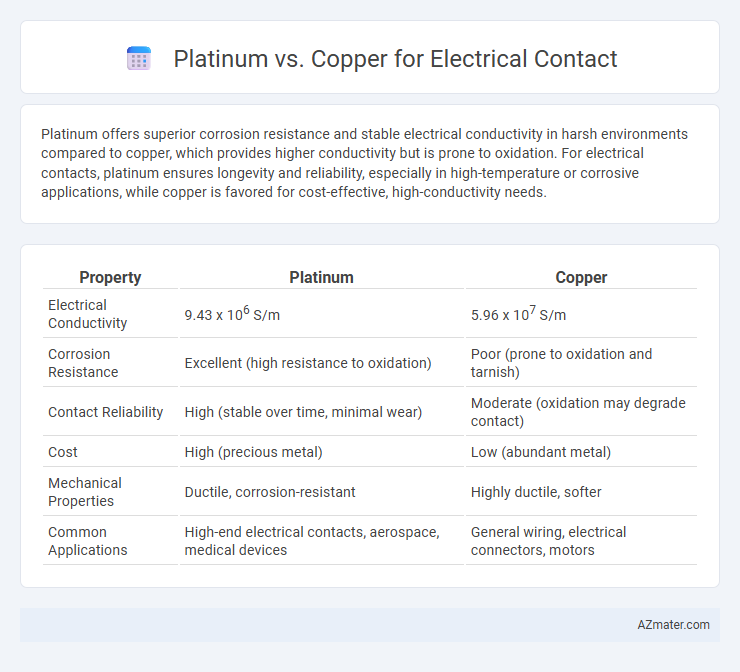Platinum offers superior corrosion resistance and stable electrical conductivity in harsh environments compared to copper, which provides higher conductivity but is prone to oxidation. For electrical contacts, platinum ensures longevity and reliability, especially in high-temperature or corrosive applications, while copper is favored for cost-effective, high-conductivity needs.
Table of Comparison
| Property | Platinum | Copper |
|---|---|---|
| Electrical Conductivity | 9.43 x 106 S/m | 5.96 x 107 S/m |
| Corrosion Resistance | Excellent (high resistance to oxidation) | Poor (prone to oxidation and tarnish) |
| Contact Reliability | High (stable over time, minimal wear) | Moderate (oxidation may degrade contact) |
| Cost | High (precious metal) | Low (abundant metal) |
| Mechanical Properties | Ductile, corrosion-resistant | Highly ductile, softer |
| Common Applications | High-end electrical contacts, aerospace, medical devices | General wiring, electrical connectors, motors |
Introduction to Platinum and Copper in Electrical Contacts
Platinum is valued for its exceptional corrosion resistance and stable electrical conductivity, making it ideal for high-reliability electrical contacts in harsh environments. Copper offers superior electrical conductivity and cost-effectiveness but is more prone to oxidation and wear compared to platinum. Both metals are chosen based on specific application requirements, balancing conductivity, durability, and environmental resistance.
Key Properties of Platinum vs Copper
Platinum exhibits superior corrosion resistance and high conductivity, making it ideal for electrical contacts in harsh environments where reliability is critical. Copper offers excellent electrical conductivity and affordability but is prone to oxidation and wear, which can degrade contact performance over time. The choice between platinum and copper depends on the application's durability requirements and environmental conditions, with platinum preferred for high-reliability and long-life contacts.
Conductivity Comparison: Platinum vs Copper
Copper exhibits significantly higher electrical conductivity than platinum, with copper's conductivity roughly 5.96 x 10^7 S/m compared to platinum's 9.43 x 10^6 S/m, making copper the preferred choice for efficient electrical contacts. Despite platinum's lower conductivity, its superior corrosion resistance and stability under high temperatures make it valuable for specialized applications where durability outweighs conductivity. Engineers often select copper for general electrical contacts requiring optimal conductivity while opting for platinum in harsh environments that demand long-term reliability.
Corrosion Resistance and Longevity
Platinum exhibits superior corrosion resistance compared to copper, making it ideal for electrical contacts exposed to harsh or corrosive environments. Its inherent chemical stability ensures long-lasting performance without degradation, whereas copper tends to oxidize and deteriorate over time. This enhanced durability of platinum significantly extends the lifespan of electrical contacts in critical applications.
Mechanical Strength and Wear Resistance
Platinum exhibits superior mechanical strength compared to copper, making it more resistant to deformation and sustainment under mechanical stress in electrical contacts. Its high wear resistance enables prolonged operational life by minimizing erosion and material loss during repeated electrical switching. Copper, while offering excellent electrical conductivity, tends to deform and wear faster under mechanical and electrical loads, limiting its durability in high-stress contact applications.
Cost Analysis: Platinum vs Copper
Platinum electrical contacts exhibit higher material and production costs compared to copper, with platinum priced approximately 30 to 40 times more per ounce than copper, significantly impacting overall device manufacturing expenses. Despite copper's cost advantage, platinum offers superior corrosion resistance and stability, often justifying its premium in high-reliability applications where contact longevity reduces maintenance costs. Cost analysis must balance initial expenditures with lifecycle value, considering factors like contact resistance degradation and replacement frequency when choosing between platinum and copper contacts.
Applications in Electrical and Electronics Industries
Platinum offers superior corrosion resistance and stable electrical conductivity, making it ideal for high-precision electrical contacts in medical devices and aerospace electronics. Copper provides excellent electrical conductivity and cost efficiency, making it widely used in power distribution, circuit boards, and connectors. Both metals are essential in electronics industries, with platinum preferred for environments requiring durability and copper for high current applications.
Environmental and Safety Considerations
Platinum offers superior corrosion resistance and non-toxicity, making it a safer choice for electrical contacts in harsh environments where exposure to chemicals or moisture is common. Copper, while highly conductive, is prone to oxidation and can release harmful copper ions under certain conditions, raising environmental and health concerns during disposal or recycling. The stable chemical properties of platinum also reduce environmental impact by minimizing the release of pollutants compared to copper-based contacts.
Maintenance and Reliability Factors
Platinum offers superior corrosion resistance and stable conductivity, significantly reducing maintenance frequency compared to copper in electrical contacts. Copper's higher susceptibility to oxidation and wear requires more frequent inspections and replacements, impacting long-term reliability. The durability of platinum contacts ensures consistent performance in harsh environments, making it a preferred choice for critical and high-reliability applications.
Conclusion: Choosing the Right Material for Electrical Contacts
Platinum excels in corrosion resistance and longevity, making it ideal for high-reliability electrical contacts in harsh environments. Copper offers superior electrical conductivity and cost-effectiveness, suitable for general-purpose applications with lower environmental stress. Selecting the right material depends on balancing performance requirements, environmental exposure, and budget constraints to ensure optimal contact durability and efficiency.

Infographic: Platinum vs Copper for Electrical Contact
 azmater.com
azmater.com